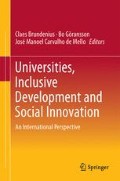Abstract
This concluding chapter gives an overview of social inclusiveness at universities in the 11 countries covered in this book. Which are the most important obstacles for young people to do higher education studies, why do such obstacles remain, and what, if anything, is being done about it? One interesting aspect of the country studies is the difference when it comes to the role of private universities and other higher education institutions (HEIs). In some countries enrolments in private universities are quite sizable, at par with public universities. In other countries private higher education is nil or negligible. There are as a rule tougher access criteria at private HEIs than at public HEIs. This goes above all for tuition fees that can be very high at private HEIs, which means that most families cannot afford to send their children to private schools. It is true that the higher tuition is often justified by the quality of teaching being considered better in private HEIs, but this is not always the case. The chapter also discusses which facilities are available to students to finance their studies: government and other stipends, and/or loans at preferential conditions.
The author gratefully acknowledges important contributions to this overview by Thiago Renault, Carlos Aguirre, Galia Figueroa, Rodrigo Arocena, Bitrina Diyamett, Glenda Kruss, Ngoc Tran Ca, Valentina Poliakova, Anda Adamsone-Fiskovica, and Birgitte Gregersen.
Access this chapter
Tax calculation will be finalised at checkout
Purchases are for personal use only
Notes
- 1.
The Gross Enrolment Ratio (GER) is measured by taking total enrolments divided by the approximate corresponding age group, in the case of tertiary education: the cohort 18–25 years. This is the reason why the ratio can be higher than 100 %.
- 2.
PPP$, purchasing power parity, also called “international dollars.” The base year is 2011, that is, the values are expressed in 2011 PPP$.
- 3.
The GINI Index is a measurement of the income distribution of a country’s residents. This number ranges between 0 and 100.
- 4.
Life expectancy in social science is the statistical age until which a person can be expected to live.
- 5.
Number of infants dying before reaching 1 year of age, per 1000 live births.
References
Brundenius, C. (2002). Cuba: The retreat from entitlement? In C. Abel & C. M. Lewis (Eds.), Exclusion and engagement: Social policy in Latin America. London: Institute of Latin American Studies.
Moehlecks, S. (2004). Acões afirmativas no ensino superior: Entre a excelência e a justice social. Educação e Sociedade Campinas, 25(88), 757–776.
Mwamila, B. L., & Diyamett, B. (2011). Tanzania: The evolving role of universities in economic development. In B. Göransson & C. Brundenius (Eds.), Universities in transition: The changing role and challenges for academic institutions. New York: Springer.
Leigh-Ann Naidu et al. (2016) How to take free public education from pipe dream to reality. retrieved at: https://www.wits.ac.za/news/latest-news/in-their-own-words/2016/2016-06/how-to-take-free-public-higher-education-from-pipe-dream-to-reality.html.
Nyakunga, R. Z. (2011). Cost sharing and academic performance: A case of Mzumbe University. Tanzania: Morogoro Main Campus.
SARUA. (2015). South Africa Data File 2012. Retrieved from http://www.sarua.org/files/Country%20Reports%202012/South%20Africa%20data%20profile%20Eng.pdf.
UIS/UNESCO. (2016). Retrieved from http://www.uis.unesco.org/Education/Pages/mean-years-of-schooling.aspx, http://data.uis.unesco.org/Index.aspx?DataSetCode=EDULIT_DS.
UNDP. (2015). Human Development Report 2015. Retrieved from http://report.hdr.undp.org/.
UniDev Country Team Data.
World Bank (2016). World development indicators. Retrieved from http://data.worldbank.org/indicator/NY.GDP.PCAP.PP.KD.
Author information
Authors and Affiliations
Corresponding author
Editor information
Editors and Affiliations
Rights and permissions
Copyright information
© 2017 Springer International Publishing Switzerland
About this chapter
Cite this chapter
Brundenius, C. (2017). Universities and Inclusiveness: An Overview. In: Brundenius, C., Göransson, B., Carvalho de Mello, J. (eds) Universities, Inclusive Development and Social Innovation. Springer, Cham. https://doi.org/10.1007/978-3-319-43700-2_16
Download citation
DOI: https://doi.org/10.1007/978-3-319-43700-2_16
Published:
Publisher Name: Springer, Cham
Print ISBN: 978-3-319-43698-2
Online ISBN: 978-3-319-43700-2
eBook Packages: Business and ManagementBusiness and Management (R0)

